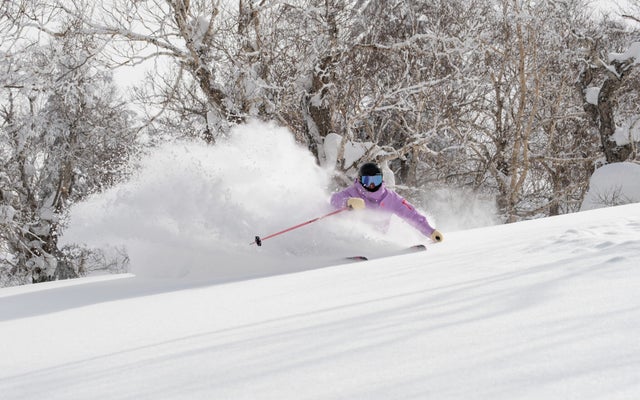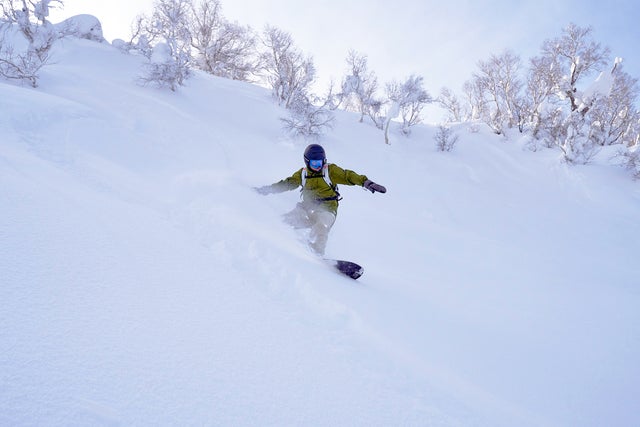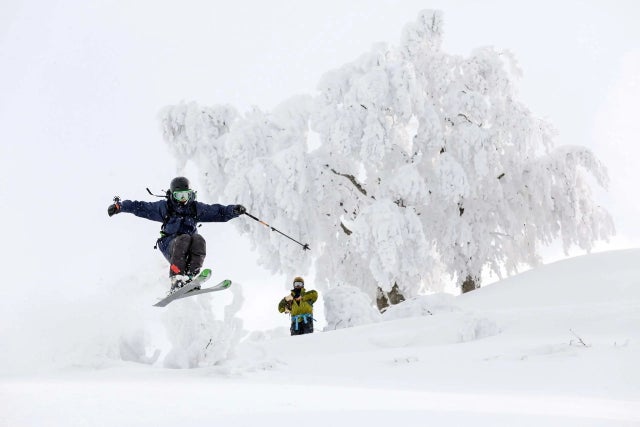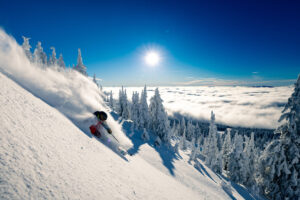Recent years have seen a number of Japan ski resorts added to many of the major multi-resort ski passes, including the Epic Pass, Ikon Pass, The Mountain Collective, and Indy Pass. So if you’re wondering where you can use your multi-resort ski pass in Japan, then you’re in the right place. Below we give you the full rundown of how the multi-resort ski passes work in Japan, which resorts you can visit, how much you can save, and the best Japan ski trip itineraries for maximizing your ski pass.
Make The Most Of Your Multi-Resort Pass In Japan
The Epic Pass
How the Epic Pass works in Japan: Epic Pass skiers and riders get five consecutive days at Rusutsu in Hokkaido, plus five consecutive days at any combination of the 10 ski resorts in Hukuba Valley, on the main island of Honshu. However, note that the Epic Pass works a little different in Japan. Here, you’ll use your mobile pass to collect a five-day lift pass at the ticket counter, which must be used on consecutive days. If you redeem your ticket on Tuesday, for example, then you can only access the lifts from Tuesday to Saturday.
Pass value: A regular five-day adult lift pass at Rusutsu costs ¥59,000 ($400) and ¥50,000 ($340) at Hakuba Valley. However, getting individual passes at each resort on the day of is cheaper than buying the Hakuba Valley pass, as one-day passes range from ¥4,700 to ¥ 9,500 (see below). Using all 10 days across both resorts is worth more than $700.
Access at Rusutsu: Epic Pass, Local Pass, Adaptive Pass, Australia Pass, and Australia Adaptive Pass: 5 consecutive days (no restricted dates).
Access at Hakuba Valley: Epic Pass, Local Pass, Australia Pass: 5 consecutive days. Epic Australia Adaptive Pass: No access for 2025-26, 5 consecutive days for the 2026-27 season (No restricted dates).
Hakuba Valley includes 10 mostly separate resorts, but the areas of Cortina/Norikura and Goryu/Hakuba 47 are interlinked (cost of a one-day adult lift pass is shown below to help you decide which resorts to use your free pass at to maximize value):
-Jigatake Snow Resort (weekday ¥4,700/weekend ¥5,200 or approximately $30/$34)
-Kashimayari Snow Resort (¥5,500 or $36)
-White Resort Hakuba Sanosaka (¥5,400 or $35 )
-ABLE Hakuba Goryu Snow Resort (¥9,500 or $61, includes Hakuba 47)
-Hakuba 47 Winter Sports Park (¥8,500 or $55, includes Goryu)
-Hakuba Happo-one Snow Resort (¥8,700 or $56)
-Hakuba Iwatake Snow Field (¥6,500 or $42)
-Tsugaike Mountain Resort (¥8,200 or $53)
-Hakuba Norikura Onsen Snow Resort (¥6,200 or $40, includes Cortina)
-Hakuba Cortina Snow Resort (¥6,200 or $40, includes Norikura)

How to make the most of the Epic Pass in Japan: Ideally you would make a two-week trip in Japan if you have an Epic Pass. For example, start out with two days in Tokyo to get acclimated to the time difference. Then five days in Hakuba Valley, a day off for a short flight to Sapporo in Hokkaido, five days at Rusutsu, and a day in Sapporo before returning home. This way you fully maximize your Epic Pass allocation and won’t spend a penny on lift passes. The journey from Hakuba to Rusutsu takes around 7-8 hours if you fly from Matsumoto or Tokyo to New Chitose Airport. Alternatively, you could stick to one area, stay for longer, and buy passes for the resorts that aren’t on the Epic pass. Niseko is right next to Rusutsu, while other popular Japan ski resorts are within reach.
You could easily spend 10-14 days in the Hakuba Valley without getting bored. If you’re there for five days, then we recommend visiting the linked areas of Cortina and Norikura, Goryu and Hakuba 47, and the standalone resorts of Happo-One, Iwatake, and Tsugaike. These are the larger, more developed resorts. Also, it’ll maximize your pass since these are the resorts with more expensive tickets at ¥6,000-10,000. Yet even the higher end of the ticket prices are much less than lift tickets in North America.
See our full overview of Hakuba Valley’s 10 resorts for a more in-depth look at the best resorts to visit and more. If you want to tick off the remaining smaller resorts, day passes are around ¥5,000 ($32), but you may want to return for multiple days at the bigger resorts. There are also many other great ski areas to visit in the Japanese Alps that aren’t on the pass. Just a two-hour drive away, Shiga Kogen boasts 18 interlinked resorts with more than 80 runs.
Ikon Pass
The Ikon Pass gives you seven days at each of the following Japan ski resorts: Niseko United, Arai Mountain Resort, Shiga Kogen Mountain Resort, Mt.T, Myoko Suginohara Ski Resort, APPI Resort, Furano Ski Resort, Nekoma Mountain, and Zao Onsen Ski Resort. The Ikon Base Pass gives you five days at each resort. The Ikon Session Pass can be used at Niseko United, but it costs more than an equivalent duration Niseko United pass.
How it works in Japan: The Ikon Pass works in Japan as it typically does elsewhere. You’ll head to the lift gates, scan your pass, and get straight on the lift. Your allocation of tickets can be used whenever you want (barring blackout dates) and they don’t need to be used consecutively.

Pass value: Regular one-day passes at the collection of Ikon resorts span from ¥6,300 ($42) at Nekoma Mountain to ¥13,000 ($85) at Mt. T. If you have the full Ikon Pass and manage to use all seven days at all nine resorts for a total of 63 days, it’s worth up to ¥561,600 ($3,700). For the Base Pass, it’s up to ¥416,500 ($2,750).
Access to Niseko United: Ikon Pass: 7 days, Ikon Base Pass: 5 days (blackout dates apply), Ikon Session Pass: 2, 3, or 4 total days (blackout dates apply).
Access to Arai Mountain Resort, Shiga Kogen Mountain Resort, Mt.T, Myoko Suginohara Ski Resort, APPI Resort, Furano Ski Resort, Nekoma Mountain, Zao Onsen Ski Resort: 7 days on the Ikon Pass and 5 days on the Ikon Base Pass.
Restrictions: The Ikon Base Pass and Ikon Session Pass cannot be used at Niseko during the following peak dates: Dec 27-31, 2025; Jan 17-18, 2026; Feb 14-15, 2026.
Additional Benefits that apply in Japan: Another perk is 25% off lift tickets for friends and family at Niseko (must be purchased 24 hours in advance).
How to make the most of the Ikon Pass in Japan: One of the big differences with the Ikon Pass, in contrast to the Epic Pass, is that you can be more flexible because you don’t need to use your days consecutively. For a Hokkaido ski trip, to visit Niseko and Furano, you could also add day trips to Rusutsu, which is nearby (and pay for a pass), and other Hokkaido resorts such as Kiroro and Kamui, without sacrificing any of your allocated days. Niseko United has everything you would expect from a major US or Europe ski resort, plus much more. Spending seven days here is a good plan. Furano, famous for its dry powder, is about three and a half hours away by car.
The remaining seven resorts are on the main island of Honshu. Three of the resorts on the Ikon Pass are clustered around the north side of Nagano: Arai Mountain Resort, Shiga Kogen Mountain Resort, and Myoko Suginohara Ski Resort. The backcountry-focused Mt. T is also reachable, taking around three hours from the other resorts.
The best plan is to hire a vehicle and base yourself in a local town such as Myoko Kogen (12 minutes from Myoko Suginohara, 25 minutes from Arai, and 50 minutes from Shiga Kogen). That’ll also allow you to visit other nearby resorts that aren’t on the pass. Staying here gives access to the other four Myoko ski resorts that neighbor Myoko Suginohara: Akakura Onsen, Akakura Kanko, Ikenotaira, and Seki Onsen. Madarao Mountain Resort is also close (25 Minutes’ drive east of Myoko Kogen). One-day passes range from just ¥3,900 ($26) to ¥8,500 ($58). These are mostly good-sized, traditional Japanese resorts with decades of history.

Zao Onsen Ski Resort is just over two hours north from Nekoma Mountain. Therefore, it would make sense to combine these two large resorts–by Japanese standards–on a single trip. You could also buy a day pass at some of the other eight smaller ski areas neighboring Nekoma, including Grandeco, as well as Minowa, which has great sidecountry that’s easy to access. These ski areas are very reasonably priced and provide a more authentic locals’ experience.
APPI Resort flies under the radar, since it’s in Northern Honshu, away from the famous ski areas. Yet it’s easily in the top 10 ski resorts in Japan for total length of pistes. It also has acres of both officially managed tree runs and unofficial sidecountry. Staying here for five days or a week on the uncrowded slopes is the perfect way to get yourself used to deep powder in a relaxing environment.
The Mountain Collective
The Mountain Collective Pass gives you two days at Niseko United with no blackout dates, plus 50% off additional days and 20% off gear rentals at Rhythm Japan. This might not seem as good as the other passes, but if you’re happy to only ski Niseko United, then you can add an unlimited number of one-day passes at 50% off. That’s just ¥6,000 ($40), which is a great value if you intend to stay longer. You can also get eight lift tickets per season for friends and family (blackout dates apply). If you have this pass, any length of time spent visiting Niseko is good use.

The Indy Pass
The Indy Pass (sold out for the 2025-26 season) gets you two days free at a long list of independent resorts throughout Japan, plus 25% off a third day pass. You could spend five to seven days at the bigger resorts, like Madarao, Kiroro, Aomori Spring, and Kamui Ski Links, but pay for additional passes. The Indy Pass is best used on a ski road trip focused on variety. The Japanese resorts on the Indy Pass are clustered around areas where you can base yourself and drive to each resort within an hour or so. Below are a few resorts that aren’t as close, but can be added on to a road trip on the way or as an overnight stay from your base. Note: Unless stated, all resorts listed below are included on the Indy Pass in Japan.
Asahikawa, Hokkaido
Asahikawa is a great base for a ski road trip in Hokkaido. There are plenty of reasonably-priced hotels, good nightlife, and several ski areas nearby where you won’t find any lift lines. On the way from New Chitose airport to Asahikawa, you can make a stop at Mt Racey for a warm-up, then when you’re in Asahikawa, you can visit Kamui Ski Links and Pippu. Nayaro Piyashiri is a bit of a stretch at nearly two hours, but an overnight stay could be worth it if you want to get truly off the beaten track. The destination resort of Kiroro is 2 hours and 30 minutes away by car and can easily be added to this trip.
While they aren’t on the Indy Pass, the truly epic backcountry-focused mountains at Asahidake Ropeway and Kurodake Ropeway are also within striking distance, at around an hour’s drive, and are well worth a visit with a guide. We recommend Whiteroom.

Ishiuchi, Yuzawa
Yuzawa is the place to visit if you are in Tokyo and want to take a quick train trip to spend a weekend in the mountains. The three resorts here on the pass, Maiko, Muica, and Yuzawa Nakazato, would suit beginners or intermediates, and they are close enough together that you can get by without a car. Gala Yuzawa is the famous resort around here (not on the pass), so if you were planning to visit, you could tick off these three Indy Pass resorts as well.
Nagano City, Nagano
Some of these resorts are in the same region around Nagano, but it’s hard to make the case for all of them as a reasonable road trip. Togakushi is worth a detour on your way up from Tokyo or Nagano City. You could then spend four days at Madarao, a large resort by Japanese standards, and its smaller neighbor, Tangram Ski Circus. Cupid Valley is a 90-minute drive away, but there are better resorts close by that aren’t on the pass with reasonably priced lift tickets (see the section on Arai Mountain Resort above). Palcall Tsumagoi is worth a visit on the way back to Tokyo, especially if terrain parks are your thing, or you want to take advantage of the free lessons. La Colina offers guided tours in the area.
Yunohira Onsen, Gifu
Dynaland, Hirugano Kogen, Takasu, Washigatake, and Whitepia in the Takasu Mountains are all within a 20-minute drive of Yunohira Onsen. Some of the resorts are popular among locals since there are very few ski resorts this far south. If you’re in Nagoya City in the winter with a spare few days and you have an Indy Pass, then it makes sense to head up the mountains; otherwise, you’ll find better snow at the other areas listed here.
Morioka, Tohoku
Morioka and its surrounding resorts are an established ski road trip route. All the resorts here on the Indy Pass are worth a one or two-day visit for deep powder and uncrowded slopes. Shimokura, Amihari, Tazawako, Okunakayama, and Geto Kogen are around an hour from the city. Aomori Spring works as an add-on with a two or three-night stay at the Rockwood Hotel, as does Ani. Both are wonderfully deserted and have great sidecountry and backcountry options. Ani’s in-bounds area is relatively small, so you’ll need a guide to take full advantage.
Aomori Spring also has a superpipe, which is rare in Japan. Note: It limits public ticket sales to just 1,200 a day. Both are a two-hour and 30-minute drive from Morioka. Japan Ski Tours offers tours in the area based on the Indy Pass. It’s also worth buying a lift pass at Appi Kogen, the largest resort in the Morioka area.

Which Multi-Resort Pass Is Best For Japan
For a first trip to Japan staying in one place, either the Epic Pass for Hakuba or the Ikon Pass for Niseko is a good choice. You get multiple days at one of the top two destinations in Japan with the best snow, terrain, facilities, and English-speaking staff. Plus, regular passes are expensive, so you can make big savings. If you want to stay longer at Niseko, then The Mountain Collective is a good bet. If you crave variety, uncrowded slopes, and want to see more of the real Japan, the Indy Pass or the Ikon Pass are both great multi-resort pass choices.
Header image: ©Niseko United





